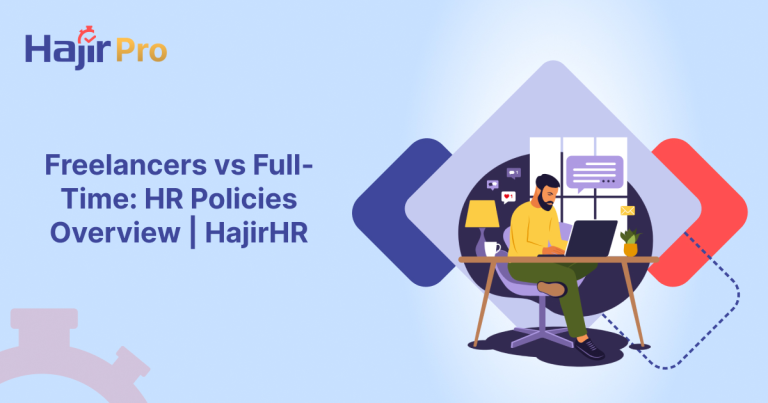Freelancers vs Full-Time: HR Policies Overview | HajirHR
HR policies for freelancers and full-time employees require clarity in leave, payroll, and performance. HajirHR automates tracking, payroll, and compliance.
 Freelancers vs Full-Time: HR Policies Overview | HajirHR
Freelancers vs Full-Time: HR Policies Overview | HajirHR
HR policies are the pillar of workforce management in any organization. Whether a freelancer or a full-time employee, the clarity of the structure of HR policies will stabilize the current operations, minimize conflicts, and maintain productivity. HR policies establish the regulations in place with regard to attendance, leave, payroll, performance appraisals, benefits, and workplace conduct.
In the modern-day business world, where freelancers and full-time employees exist side by side, it is important to learn the distinction that exists in the management of the two. The firms must implement HR practices with a flexible and comprehensive approach that will support different forms of employment without undermining operational effectiveness.
Organizations can use the services of platforms, such as HajirHR, to optimize HR operations and to ensure that they are compliant and easily manageable across all categories of employees.
Understanding Freelancers in the Modern Workplace
Freelancers are project-based or task-based independent professionals. They are flexible and can be of specialist knowledge that may not be owned by organizations. Freelancers are used by many startups or even big businesses when they need a short-time, technical, or creative task.
Advantages of Freelancers
- Cost Savings: No full-time salaries, benefits, or long-term commitment.
- Specialized skills: The ability to tap into a specific field of expertise that is not available in-house.
- Flexibility: Get the work done when it is required, whether short- or long-term.
- Scalability: Having an opportunity to upsize or downsize the workforce easily and avoiding excessive overhead costs.
Challenges with Freelancers
- Accountability Problems: Little control relative to full-time workers.
- Tracking and Monitoring: It's hard to trace attendance, performance, and work progress.
- Risk of Timely Delivery: Deadlines can be at risk because freelancers have more than one client.
- Cultural Integration: Integrating freelancers into company value systems and systems is difficult.
Full-Time Employees and HR Policies
The traditional workforce represents the full-time employees: those who have permanent employment contracts with set work schedules and specified benefits. Full-time employees need to have HR policies in place that address every part of employment.
Full-Time Employee Benefits
- Stability & Commitment: endorse consistency and dependability.
- Cultural Alignment: Learn about and adjust your values and procedures to those of the company.
- Systematic Growth: He/she can be trained, worked with, and become part of shared knowledge.
- Strategic Contribution: Be involved in the strategies and help to elevate business.
Issues Regarding Full-time staffing
- Increased Expenses: Needs payments, bonuses, and abiding by the labor acts.
- Resource-Heavy Administration: HR systems required to provide payroll, leave, and performance monitoring.
- Risk of Disengagement: The low work motivation or condensation affects the productivity.
- Policy requirements: Regular adaptations so as to maintain fairness and to ensure the preservation of high morale in the company’s environment.
Comparing HR Policies: Freelancers vs Full-Time
The nature of the employment should make a difference in the policy drafted by the HR. The following are the major differences in the application of policies between the freelancers and full-time employees.
1. Leave and Attendance Management
It is characteristic of full-time employees that they have clear leave policies, including sick leave, casual leave, and paid leave. Freelancers, on the contrary, tend to be paid according to delivered projects with no strict hours, and the time-off policy does not always apply to them.
2. Payroll and Compensation Policies
Full-time employees include fixed salaries, bonuses, and statutory deductions on payroll. Freelancers are evaluated by project, by hour, or by task accomplished. It is a time-consuming and error-prone task to manage these various payment structures manually.
3. Performance Evaluation and Monitoring
KPIs, appraisals, and feedback are used to conduct performance evaluations on a scheduled basis with full-time employees. Freelancers are measured by considering whether they have been able to finish the projects, their quality, and their timely delivery.
How HajirHR Helps in Managing HR Policies
Tracking Employee Attendance and Freelancer Engagement
HajirHR does the work of managing HR by automating the attendance records of the full-time employees and monitoring the engagement and progress of the freelancers with the standup and prosper feature. This minimizes the human error and enhances adherence to company policy.
Payroll Simplification
Processing of payrolls may also be complicated with various forms of employment. Payroll management with HajirHR is a simple task because it takes into consideration salaries, payments to freelancers, and tax deductions and necessary compliance.
Workforce Insights
HajirHR offers real-time reports of full-time employees. Project progress and task completion can be monitored by using the standup and prosper feature, as in the case of freelancers. Freelancers can also be updated/notified in real time regarding any changes. This assists the HR managers in making sound decisions, using resources more efficiently, and ensuring overall workforce satisfaction.
Full blog: https://hajirhr.com/blog/freelancers-vs-full-time-hr-policies/